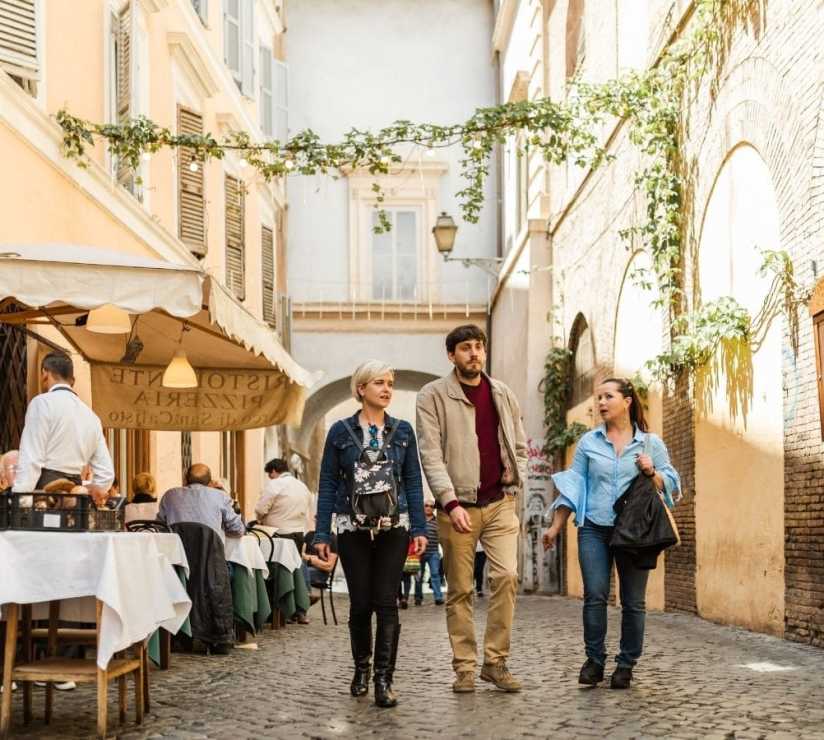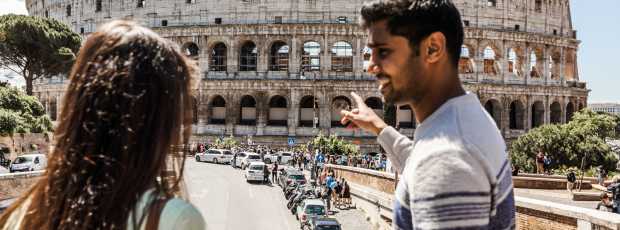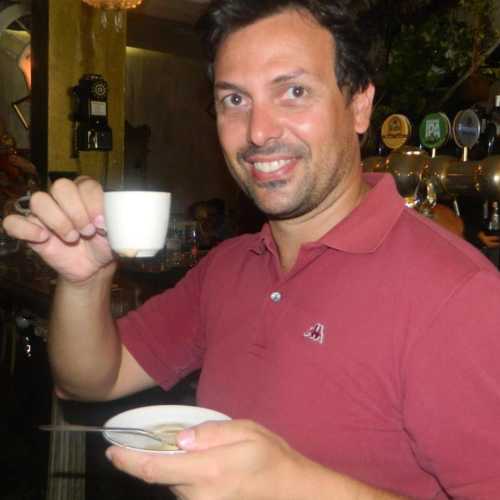See Rome’s hidden side on a private tour
Private tours, designed around you
Table Of Contents
- Iconic Spots at Night: Ancient Rome Without the Chaos
- Authentic Food Experiences: Eating Like Romans Do
- Hidden Gems and Quiet Corners: Where Romans Hide at Night
- Vibrant Local Culture at Night: Romans Being Romans
- Practical Tips: Making Night Rome Work for You
- Frequently Asked Questions About Rome at Night
- Explore Rome the Way It's Meant to Be Seen
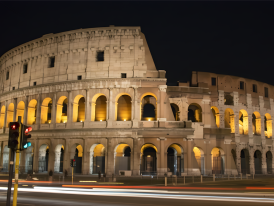
Colosseum illuminated at night with amber lighting against a dark sky
I've spent 34 years in these streets, and the last decade showing visitors the version of this city that doesn't show up in guidebooks. Rome at night is a completely different animal from the sweaty, crowded, selfie-stick nightmare you get during the day. The Colosseum lit up against a dark sky, the Trevi Fountain lit without 500 people blocking your view, Trastevere when the locals are sitting outside their favorite spots instead of tourist traps serving microwaved carbonara. That's the Rome experiences worth staying up for.

St. Peter's Square colonnade illuminated at night with dramatic lighting
Iconic Spots at Night: Ancient Rome Without the Chaos
Here's what nobody tells you: Romans designed this city for evening life because daytime in Rome is brutal. Always has been. The emperors held their events at night in the Colosseum, the forums stayed open until dark, and the baths were busiest after work. We've been night people for 2,000 years.
My nonno used to say that Rome at night is when the city remembers what it really is, and the old man wasn't wrong. During the summer months, the only people wandering around at 2 PM are tourists who don't know better and are about to learn what heat exhaustion feels like. Locals stay inside until the sun sets, then the whole city pours out. Families strolling through the city center, couples arguing about where to eat (always arguing about food), and teenagers on Vespa heading to meet friends.
The Colosseum Lit: Better Outside Than In
The Colosseum lit from the outside beats going inside during the day, and I'll fight anyone who disagrees. That amber lighting makes the travertine look like it's on fire. You can think about what happened there instead of surviving the experience of being crammed in with massive crowds who can't see anything anyway.
If you want to visit inside, book a night tour. The arena floor under the moon, hearing about gladiators without someone's iPad blocking your view, learning about ancient Rome from someone who doesn't have to yell over 50 other guides. I did the Colosseum during the day exactly once in my life, for a school trip when I was 12. Never again.
Trevi Fountain Lit: Skip the Daytime Madness
The Trevi Fountain at night is worth missing sleep for. Yeah, it's still got crowds, but show up around 11 PM and you can get close enough to see Oceanus without someone's backpack in your face. Stand to the left side near the café, not in the center where everyone's fighting for the same photo. That's where the lighting hits the sculptures best anyway, makes the water look like it's glowing.
Last month I brought a small group there at midnight. The woman from Chicago started crying when she saw it, which happens more than you'd think. When you can hear the water and see the details Salvi carved into those horses, it hits differently than pushing through masses at noon while some guide shouts facts through a megaphone.
Roman Forum and Capitoline Hill: History You Can Hear
The Roman Forum and Capitoline Hill at night let you experience Rome's history without the circus. My friend Marco leads tours through there after dark and says people retain information instead of shuffling through in a daze. The columns casting shadows, the ruins lit up, and being able to stand in one spot for more than 30 seconds without getting pushed along.
The forum was the center of ancient Rome for centuries. Politicians made speeches there, markets operated, and citizens gathered to hear news. At night, when it's quiet, you can almost hear the echoes of all that life. This open-air museum becomes something you can understand instead of just photographing.
Vatican Museums and St. Peter's Square After Dark
The Vatican Museums do special night openings at certain times of year. The Sistine Chapel without the usual chaos is the only way to see it. I took my cousin's kids last summer during a night tour, and they looked up at Michelangelo's ceiling instead of trying to survive the mob. The extra cost is maybe €10 more than daytime tickets. Best €10 you'll spend in Rome, Italy.
St. Peter's Square at night is genuinely impressive in a way that daytime can't match. The colonnade lit up, Bernini's statues overhead, the whole space feeling both massive and somehow intimate. I brought my sister there at midnight once after she'd had a rough week. She just stood in the center for 20 minutes, didn't say anything, didn't take photos. That's what Rome's history does when you give it space.
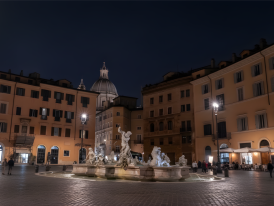
Piazza Navona fountain lit up at night with the surrounding baroque architecture
Authentic Food Experiences: Eating Like Romans Do
Listen, if you're eating dinner before 8 PM in Rome, you're either eating with other tourists or you're eating alone. Romans love their dinner late, always have. My sister and I usually sit down to eat around 9 PM, sometimes 9:30 PM. That's normal here.
Food Tours Through Neighborhoods That Matter
A proper food tour at night takes you where restaurants are busy with actual Romans. Trastevere after 8 PM is when the good spots open their kitchens. Da Enzo al 29 is tiny, packed, and you need reservations, but their carbonara is what carbonara should taste like. Tonnarello stays open late and serves portions that could feed three people, which is how we do things in Rome.
Want authentic Roman cuisine? Go to Flavio al Velavevodetto in Testaccio around 9 PM on a weeknight. It fills up with locals who've been coming here for years. Their cacio e pepe will make you understand why we're so uptight about how pasta's done. The pasta water-cheese emulsion is perfect, the pecorino is aged exactly right, and they don't add cream like some places do (which makes me want to throw things).
Street Food and Late-Night Supplì Runs
For street food, hit Supplizio near the Campo market around 10 PM. Their supplì al telefono (fried rice balls with mozzarella that stretch like telephone wires when you bite them) are the best in central Rome. I eat there a couple of times a week when I'm craving good supplì. Get the classic tomato sauce one and the cacio e pepe version. Both. You need both.
The Campo area transforms after the market closes. During the day, it's chaos and overpriced everything. At night, you can move through without getting knocked over by vendors, and if you know which places to avoid (most of them), there's decent Roman-style pizza at Forno Campo de Fiori. Get there before 9 PM or they run out of the good stuff.
Cooking Classes: Learning Italian Food the Right Way
Want to take a cooking class? Book the evening ones. You learn to make pasta, eat what you cooked, drink wine, and you're doing it at a civilized hour when your brain works. The morning classes feel rushed, like everyone's trying to get through it so they can see more churches. Evening classes in Trastevere or near the city center let you cook, learn, and enjoy the experience. Plus, you're eating at proper dinner time, which matters if you want to understand Roman food culture.
Where to Eat Around the Main Piazzas
The main square with Bernini's fountains is surrounded by places charging double what the foods worth because of the location. The amazing food is in the side streets, not the piazza itself. But Tre Scalini has been there since 1815, and their tartufo (chocolate ice cream ball) is worth the inflated price you pay for sitting near the Four Rivers fountain. Eat it standing up if you want to save €5. That's what locals do.
The piazza at night, with the fountains lit and performers doing their thing, is worth passing through even if you don't eat there. Just skip the restaurants with the laminated menus in six languages. Those are traps.
Looking for a private city experience in Rome?
Explore the city with a local who plans a private day just for you; no groups, no scripts.

River Tiber at night with illuminated bridges and reflections in water
Hidden Gems and Quiet Corners: Where Romans Hide at Night
Forget the Spanish Steps at night. Piazza di Spagna looks pretty lit up, sure, but sitting there means sitting with a hundred tourists doing Instagram photos. That's not experiencing Rome, that's performing for social media. If you want fewer crowds and a real atmosphere, you need to know where locals go. These are the hidden gems in Rome that make night exploring worthwhile.
Trastevere Beyond the Tourist Streets
Trastevere gets tourists now, especially the main streets, but deeper in, you still find real spots. I take people to Da Augusto in Piazza de' Renzi because it hasn't changed since my nonno ate there in the 1960s. Paper tablecloths, house wine in carafes, waiters who don't speak English and don't care. Their amatriciana is simple and perfect. Cash only, no reservations, show up early, or don't bother.
The narrow streets off Viale di Trastevere are where locals live and eat. Better prices, authentic Roman atmosphere without the performance. Walk down Via della Lungaretta after 10 PM and you'll see families sitting outside trattorias, neighbors arguing about football, real Roman life happening.
River Tiber: The Forgotten Evening Destination
The Tiber after dark is underrated. Stroll from Castel Sant'Angelo toward Trastevere along the banks. During the summer months, there are bars set up down by the water where locals hang out. Grab a beer for €3, sit on the wall, watch the river flow by like it has for thousands of years. The city offers this for free, and visitors never find it.
Castel Sant'Angelo at night, reflected in the water, is one of those stunning views that doesn't require fighting crowds or paying admission. The bridge leading to it (Ponte Sant'Angelo), with Bernini's angel sculptures lit up, is worth the visit alone. It's a wonderful way to spend an evening without joining touristy areas packed with vendors.
Neighborhood Piazzas for People Watching
For people watching without chaos, try the smaller piazzas. Piazza Santa Maria in Trastevere around 10 PM, when the fountain's lit and locals are sitting on the steps talking. Piazza Mattei with its turtle fountain, near the Jewish Ghetto. These spots let you sit, rest, and watch Romans do their thing without feeling like you're in a theme park.
Piazza Venezia and that ridiculous Victor Emmanuel Monument (the wedding cake, the typewriter, whatever you want to call it) get lit up at night and look even more absurd than during the day. Nothing about that building is subtle. I kind of love it for that.
San Lorenzo and Testaccio: Where Locals Live
San Lorenzo, where I live, is where you see authentic Roman nightlife. University students, working-class families, bars that charge normal prices instead of the €8 for a beer you pay in tourist zones. Pigneto has the same energy, maybe scruffier but real. These neighborhoods stay busy year-round with locals, and nobody's trying to scam you every five seconds.
Testaccio is where Romans go for serious Italian food. Less touristy than Trastevere, better prices, and the restaurants there have been serving the same families for generations. The night market in summer brings out food stands, live music, and actual neighborhood culture.

Panoramic view from Gianicolo Hill overlooking Rome's illuminated cityscape
Vibrant Local Culture at Night: Romans Being Romans
The thing about Rome is that nightlife here isn't about clubs and bars necessarily. It's about being outside, eating, arguing about football, sitting in piazzas until 1 AM, because why would you go home when the weather's nice? These are the things to do in Rome that locals enjoy every night.
Ghost Tours: History's Dark Side After Sunset
The ghost tour thing sounds gimmicky, but a good one shows you parts of Rome visitors miss. The Capuchin Crypt with bones arranged into chandeliers and wall decorations, the underground passages where various popes did questionable things to each other, and the spots where murders and intrigue went down. Rome's history isn't all glory and empire. Most of it is betrayal, violence, and people being terrible to each other in creative ways.
I took a ghost tour when my cousin visited from Milan (he thinks Rome is provincial, which is hilarious coming from Milan). The guide showed us execution sites, plague burial grounds, and spots where the Borgia family poisoned rivals. Nighttime makes it appropriately creepy, and you learn actual history instead of the sanitized version other tours push.
Street Performers and Open Air Entertainment
Performers near the historic center come out after sunset. Some are talented, but most want your money. The violinist who plays near the Pantheon is legitimately good. The living statue guys are boring. The fire breathers occasionally set things on fire accidentally, which is entertaining for all the wrong reasons.
For open-air cinema, Isola del Cinema on Tiber Island during summer is proper Roman entertainment. Movies outside, cheap wine, sitting on the island in the middle of the river watching films. We've done outdoor theater since ancient Rome, so this is basically tradition with modern technology.
Christmas Markets and Seasonal Celebrations
Christmas markets during the winter months pop up around Rome, and they're fine. Nothing like the German ones, but drinking vin brulé (mulled wine) in a Roman piazza while surrounded by nativity scenes works. The smaller ones in neighborhood piazzas are better than the main tourist version.
The Italian capital celebrates year-round with festivals, concerts, and events that locals attend. Check what's happening during your visit because Romans love any excuse to gather in piazzas and celebrate something.
Rooftop Bars and Sunset Views
Best sunset views are from Gianicolo Hill, hands down. The whole city spreads out below you, and as the sun sets, you watch Rome transform from day to night in real time. Free, not crowded, stunning views of the whole Italian capital. I go up there when I need to remember why I still live here after 34 years.
Rooftop bars charge €15 for a cocktail to see the worst views. Skip them unless you have money to burn. If you must do a rooftop bar, the Eitch Borromini Hotel has good views, but you're paying for location. One drink there costs what a full meal costs in Testaccio. Your choice, but I know which one leaves you more satisfied.

Pantheon portico illuminated at night with people silhouettes in foreground
Practical Tips: Making Night Rome Work for You
Here's what you need to know to visit Rome at night without screwing it up. Most people don't understand Roman timing and end up frustrated.
Transportation After Dark
- Metro hours: Closes around 11:30 PM on weekdays, runs until about 1:30 AM on Friday and Saturday nights, so plan accordingly or you're on foot.
- Night buses: Marked with an N and run after the metro closes, but they're infrequent and slow, not worth waiting for unless you have no choice.
- Getting around on foot: Central Rome is compact, making it the best way to see everything at night when it's all lit up anyway.
- Taxis: Budget for cabs if you're staying out past midnight in neighborhoods far from your hotel, they're easier than figuring out night bus routes.
- Golf cart options: Skip these gimmicky golf cart rides, you'll see more on foot, and it won't cost €80 to bounce around dodging Vespas.
Best Times and Seasons for Night Visits
- Summer months: Warm nights around 77°F (25°C) with everyone outside until 1 AM, outdoor concerts, cinema, and dining everywhere, this is when Rome lives outside.
- Winter months: Colder temperatures around 50°F (10°C) but stunning city lights, easier restaurant access without reservations, and way less tourist traffic to deal with.
- Spring and fall: Ideal weather around 68°F (20°C), pleasant nights, manageable crowds, and sunset at reasonable hours for smooth day-to-night transitions.
- Year-round appeal: Rome looks good at night in every season, each offering different vibes from summer street life to winter Christmas lights.
Safety and Common Sense
- General safety: Rome is safe at night in tourist areas and the city center. I'm out most evenings, and the biggest danger is stepping in something unpleasant.
- Pickpockets: Watch your belongings in crowded spots near major monuments, they work the tourist zones, not the residential neighborhoods.
- Phone and valuables: Keep phones in pockets and bags secured on public transport, and basic city sense that applies anywhere.
- Neighborhood safety: Areas where locals live (San Lorenzo, Testaccio, and deeper Trastevere) are safer than spots packed with tourists and the people who prey on them.
- Small group benefit: Stick to tours with 8-10 people maximum, those 30-person convoys see nothing and learn less.
What Most Tourists Miss
- Multiple sunset spots: Each piazza and hill offers different views as the city transforms. Gianicolo is best, but Pincio and Aventine have their moments too.
- Jewish Ghetto at night: Quiet evening atmosphere with locals sitting outside after dinner, kosher restaurants serving Roman-Jewish specialties, no crowds.
- Tiber hangouts: Sitting by the water doing nothing, watching the city like Romans do, instead of rushing between monuments, checking boxes.
- No agenda nights: Some of my best nights in Rome have been the ones with no plan, just seeing what happens and finding unique things along the way.
- The Pantheon after dark: Stand in front of the ancient temple at night without crowds, think about 2,000 years of people doing the same thing.
What if your day in Rome was planned by someone who knows it — and you?
City Unscripted matches you with a local host who creates a private experience based on your interests, not a set route.
Frequently Asked Questions About Rome at Night
1. What time do restaurants open for dinner in Rome?\ Most restaurants open around 7:30 PM, but don't fill up with locals until 8:30 PM or 9 PM. Showing up at 6 PM means eating alone with other tourists or finding places closed.
2. Do I need to book night tours in advance?\ Yes, especially for Vatican Museums night openings and Colosseum tours, which sell out weeks ahead. Small group options also fill up quickly during peak season.
3. Can I drink alcohol in public spaces at night?\ Yes, drinking in piazzas and streets is legal and common, though glass bottles are sometimes restricted in certain areas during summer weekends. Romans sit on steps and walls with beers regularly.
4. Are shops and stores open late in Rome?\ Most shops close between 7 PM and 8 PM, though some in tourist areas stay open later. Restaurants, bars, and gelaterias stay open until midnight or later, depending on the neighborhood.
5. How late can I hear church bells ringing?\ Church bells ring throughout the night, including hourly chimes from major churches. Light sleepers near churches should bring earplugs or book hotels in quieter residential areas.
6. Is it worth paying the additional cost for skip-the-line night tickets?\ For major sites like the Vatican Museums and the Sistine Chapel, night access is worth it to avoid daytime crowds. Regular monuments lit from outside are free to view.
7. Do guides expect tips at the end of tours?\ Tipping isn't mandatory in Italy, but appreciated for good service. €5-10 per person for group options or 10-15% for private guides is standard if you're satisfied.
8. Can I see the Trevi Fountain illuminated year-round?\ Yes, it stays lit every night of the year. Late evening (10 PM to 11 PM) offers the best viewing with smaller crowds than earlier hours, and many say it has great reviews for good reason.

Night view of Rome with Castel Sant'Angelo reflected in the Tiber River waters
Explore Rome the Way It's Meant to Be Seen
Look, my whole job is showing people Rome at night because this is when the city makes sense. Not because it's romantic or magical or any of that travel blog nonsense. Because it's real. The Italian food tastes better when you're eating at proper hours with locals around you. The ancient stones look more impressive when you're not fighting for the same photo everyone else takes. The whole Eternal City breathes differently after dark.
Romans love this place in the evening for good reason. We've been doing nightlife for 2,000 years because it works. The walking tour format, the cooking classes that end with wine and conversation, the food tours through neighborhoods where restaurants serve authentic cuisine, all of it works better when the sun's down and the city belongs to people who live here. So yes, visit Rome and see the Vatican. Stand in front of the fountain. Take your food tour and try the supplì that makes you understand why we're obsessed with street food. But do it at night in Rome when the city shows you its real face. These are the Italy experiences that stay with you long after you've gone home.
Tip
We match you with the right host, not just any guide.Want to experience the real Rome with someone who lives there?
A fully private experience, planned and led by a local host who tailors the day to you
Ready to plan your perfect day in Rome?
Start your experienceWhat if your day in Rome was planned by someone who knows it — and you?
City Unscripted matches you with a local host who creates a private experience based on your interests, not a set route.
Want to experience the real Rome with someone who lives there?
A fully private experience, planned and led by a local host who tailors the day to you
